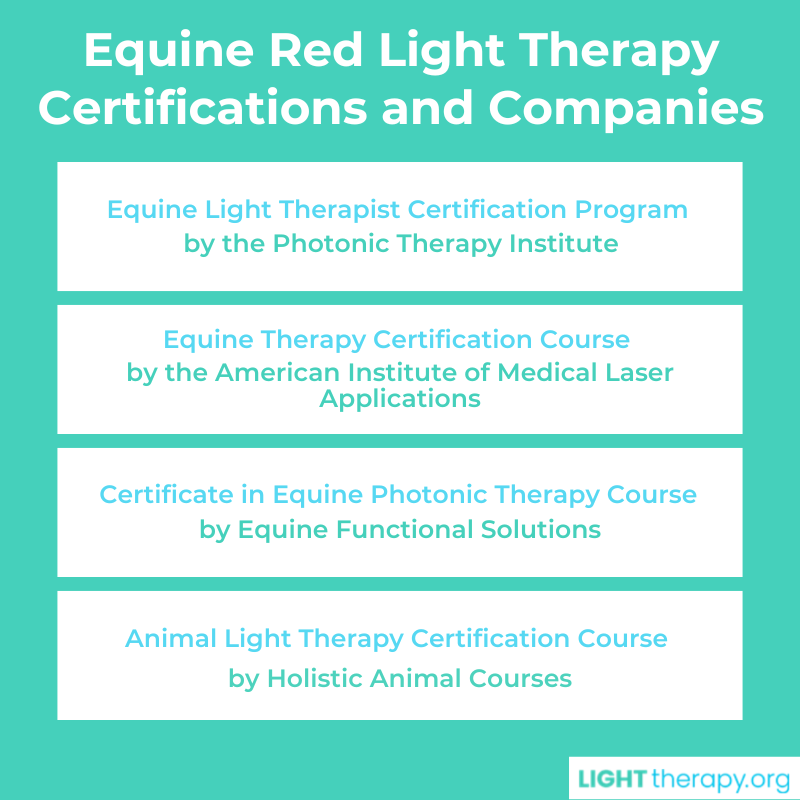Equine Red Light Therapy Certification: What You Need to Know
If you work with horses personally or professionally, you probably keep up with the latest research about treatments for common equine medical conditions.
One newly popular equine treatment is red light therapy. Whether you want to hire someone to treat your horse with red light therapy or you want to administer it yourself, you’re probably curious about qualifications and certifications.
What follows is everything you need to know about red light therapy, how it can help horses, and how (and whether) to obtain an equine red light therapy certification.
What Is Light Therapy?
Light therapy usually refers to a clinical or at-home medical treatment that uses light-emitting diodes (LEDs) to shine wavelengths of red, blue, green, or infrared light on the body. Skin cells absorb the light, become energized, and experience different positive effects depending on the type of wavelength.
Some light therapy devices use one specific wavelength of light to treat certain conditions; others use a variety.
In humans, light therapy is an effective treatment for many conditions, including acne, cold sores, wounds, burns, inflammation, chronic pain, hair loss, sleep disorders, depression, signs of aging, and more.
Red light in particular has a demonstrated ability to heal. This wavelength promotes cell turnover, expedites recovery time, encourages collagen production, and increases blood flow. Both red light and blue light also decrease inflammation, swelling, and pain.
How Can Light Therapy Help Horses?
While researchers have known for years about the benefits of light therapy for a wide variety of conditions in humans, veterinary science has only recently started exploring this technology.
Researchers have begun testing the effectiveness of multiple types of light therapy on animals, including horses, and early results have been very positive.
Blue Light Therapy for Horses
Before we explore equine red light therapy certification, we’ll briefly mention the second most popular wavelength of light therapy for horses: blue light.
Blue light therapy may increase fertility rates in horses. In order to achieve this result, a light mask is placed around the horse’s eyes for a period of time to emulate a summertime length of daylight. According to one study, this method works better than indoor artificial lights and is just as effective as natural light.
Red Light Therapy for Horses
While blue light therapy is used to help horses with fertility, red light therapy is used to heal wounds. Horses are very slow healers, and a large wound can significantly impact an animal’s ability to function.
Since studies demonstrate that red light therapy has healing effects, this option is an appealing choice for treating wounds in horses. Unfortunately, however, there is very little research on the effectiveness of equine red light therapy so far.
One small study using red and near-infrared light therapy for small skin wounds on horses’ necks didn’t show any benefit from the therapy, though it’s impossible to say whether that’s because of the particular wavelengths chosen, the power levels used, a general ineffectiveness on horses, or some other factor.
Many professional riders, trainers, and horse owners swear by red light therapy for wound healing, as well as for treating fractures, bruising, arthritis, and injuries of the muscles, ligaments, and tendons.
We’re still in the early days of using red light therapy on animals, particularly horses. Nothing is conclusive yet, and it’s difficult to reach a consensus because of the wide variety of possible wavelength, power level, and light source combinations.

Equine Red Light Therapy Certification
If you’re passionate about light therapy for horses, an equine red light therapy certification might be valuable to you, especially if you’d like to administer equine red light therapy professionally.
That said, current equine red light therapy certification programs aren’t regulated or sanctioned by governing bodies such as the American Veterinary Medical Association (AVMA). They’re simply educational materials offered by various groups interested in equine light therapy. (Note: The AVMA does tout the effectiveness of light therapy and mentions support for these treatments in clinical trials with pets.)
Several companies and organizations offer equine red light therapy certification. Here are a few you might consider:
- Equine Light Therapist Certification Program by the Photonic Therapy Institute
- Equine Therapy Certification Course by the American Institute of Medical Laser Applications
- Certificate in Equine Photonic Therapy Course by Equine Functional Solutions
- Animal Light Therapy Certification Course by Holistic Animal Courses
Or, you may prefer to take a certification course through an accredited university, such as the Equine Therapy Certification Course offered through North Carolina State University.
Because these certifications aren’t overseen by a regulating body, be sure to thoroughly research any course before signing up and check that you will receive proper accreditation upon completion. In other words, practice thorough due diligence before spending any money.
Equine Red Light Therapy Certification: Final Thoughts
If you’re passionate about horses and veterinary technology, an equine red light therapy certification could be a natural next step in your career. Few things are more rewarding to an animal-lover than keeping them safe and healthy!
Again, if you decide to pursue an equine red light therapy certification, conduct lots of research. Never give money to an organization or company without fully vetting both the group and their claims. If possible, ask for references from other professionals who have taken the course and ask them how an equine red light therapy certification has helped them.